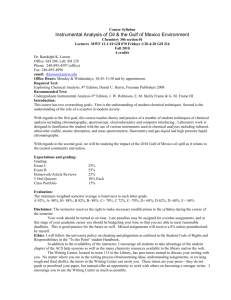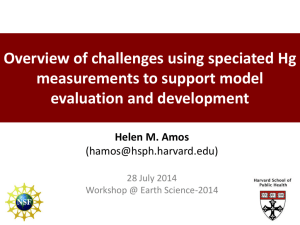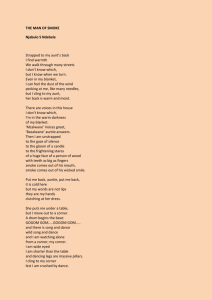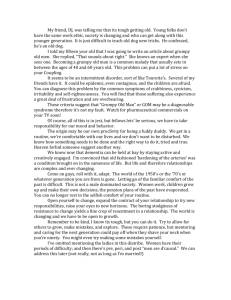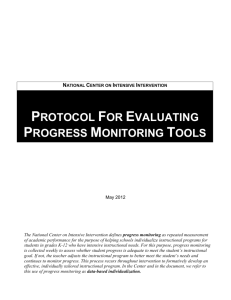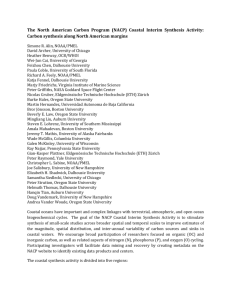Mae Sexauer Gustin
advertisement
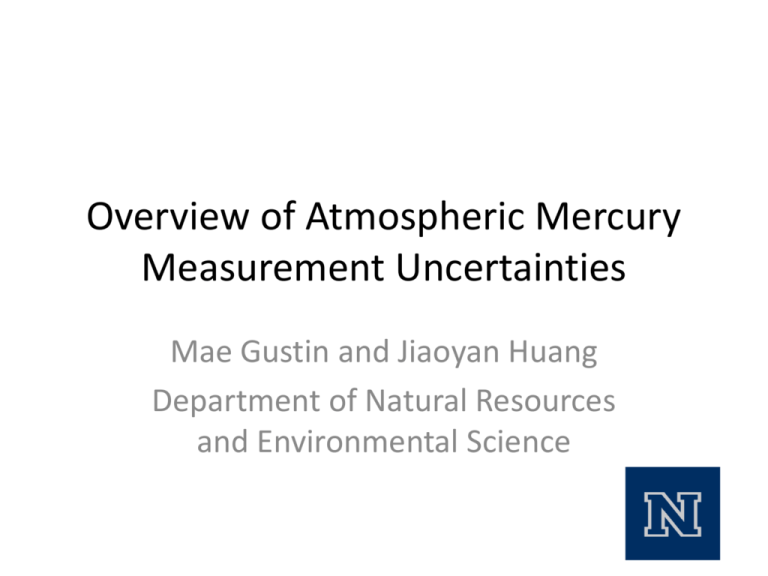
Overview of Atmospheric Mercury Measurement Uncertainties Mae Gustin and Jiaoyan Huang Department of Natural Resources and Environmental Science Acknowledgments • Funding sources – – U. S. National Science Foundation – Electric Power Research Institute –EPRI • Thanks to Gustin lab graduate and undergraduate students • Thanks to the many field site operators who have helped us Progress on Understanding Atmospheric Mercury Hampered by Uncertain Measurements Daniel A. Jaffe,*,†,‡ Seth Lyman,§ Helen M. Amos,∥ Mae S. Gustin,⊥ Jiaoyan Huang,⊥ Noelle E. Selin,# Leonard Levin,∇ Arnout ter Schure,○ Robert P. Mason,◆ Robert Talbot,¶ Andrew Rutter,∞ Brandon Finley,† Lyatt Jaeglé,‡ Viral Shah,‡ Crystal McClure,‡ Jesse Ambrose,† Lynne Gratz,† Steven Lindberg,$ Peter Weiss-Penzias,⊗ Guey-Rong Sheu,∀ Dara Feddersen,⧓ Milena Horvat,◘ Ashu Dastoor,Я Anthony J. Hynes,@ Huiting Mao,Π Jeroen E. Sonke,★ Franz Slemr,⧖ Jenny A. Fisher,∫ Ralf Ebinghaus,∮ Yanxu Zhang,× and Grant Edwards⪫ • “at present there is no consensus on what the chemical form(s) of GOM is(are),nor any reliable method to identify the chemical form(s) in the atmosphere. It is likely that more than one form of Hg(II) exists in the atmosphere, depending on its source.” and the oxidants in the air. • “protocols do not provide a way to calibrate for GOM or PBM, quantify collection efficiency or quantify measurement interferences.” • “There is some uncertainty as to whether current unspeciated measurements capture total gaseous mercury (TGM) or GEM.” EST, 2014 Tekran system -Has been useful for making progress for understanding atmospheric Hg -Being used in networks world wide --KCl-coated denuder and particulate filter not calibrated or checked for interferences Talk outline • Focus on GOM uncertainties • Brief summary of methods • Chronological discussion of investigation of GOM uncertainties • Note on PBM– instrument demonstrated to not collect all PBM (Talbot et al., 2011) – PBM likely measures GOM not collected by the denuder (Gustin et al., 2013) GOM Passive samplers Easily deployed by regular people Dry deposition No electricity needed Demonstrated use in Florida, California, Nevada, New Mexico, Oklahoma, Texas…….Maryland Lyman et al., 2009 and 2010 EST AE Huang et al., 2014 Environ. Sci.: Processes Impacts Concentrations UNR active system Tekran 1135 Tekran 1130 Dry gas meter Flow controller Vacuum pump 00014m3 Tekran 1130/2537 Developed for measurement of GOM concentrations and chemistry Huang et al. 2013 UNR laboratory manifold Ozone analyzer at 1.2 Lpm Tekran® at 4 or 7Lpm DI water source Impactor Port 4: 1 Lpm Port 3: 1 Lpm Port 2: 1 Lpm Zero air tank Port 1: 1 Lpm 2.5-5.5 Lpm RH and Temp Manifold Exhaust GOM source 0.05-0.1 Lpm Zero air filter 8-13 Lpm Developed for loading and calibrating membranes and calibrating the denuder Ambient air inlet Main pump Huang et al., 2013 Florida TMDL Study Assume the passive sampler data are correct and the Tekran data are wrong Gustin et al. 2013 ACP Peterson et al. 2012 STOTEN Passive samplers in Florida-GOM SS data corrected should be higher by 0.2 ng m-2 h-1 Recent work suggests CEC reflects natural surfaces (Huang and Gustin 2014) Measured deposition always higher than modeled Passive samplers and Tekran not always correlated Passive sampler uptake and SS deposition not always correlated Different deposition velocity of the different forms will influence uptake Peterson et al., 2012 STOTEN Conclusions Peterson et al. 2012 Investigate the utility of passive sampling systems to record spatial and temporal patterns of atmospheric Hg Samplers do record spatial and temporal variation Variation does not match that measured with the Tekran Data suggests different forms of GOM across space and time Gustin et al. 2012 based on combining criteria air pollutant data and meteorology At OLF natural background dry deposition 0.03 ng m-2 hr-1 no significant influence of the EGP LRT 0.11 ng m-2 hr-1 GOM dry deposition derived from N-NW At Tampa Mobile sources 0.2 ng m-2 hr-1 LRT in the spring 0.08 ng m-2 hr-1 Davie Local point sources 0.1 ng m-2 hr-1 LRT in the fall and spring 0.1 ng m-2 hr-1 Remember the dry deposition values were corrected and should be higher by 0.2 ng m-2 hr-1 -Limitations of current methods to measure atmospheric Hg need to be systematically addressed Reno Atmospheric Mercury eXperiment – RAMIX August to September 2011 Tekran Uncertainties Field-RAMIX In manifold GEM/TGM Response Weeks 1 to 3 [ng m-3] Spike Concentration 5 to 25 Response/Recovery (%) mean std dev max min 72 13 93 40 55 6 62 43 Instrument r2 Spec 1 Spec 2 Spec 2 adjusted 0.88 0.92 n hourly 20 16 0.92 16 0.96 47 76 9 86 60 76 12 97 35 UNR 2537 23 24 13 15 48 61 9 9 33 22 85 13 Spec 1 Spec 2 Spec 2 adjusted 16 16 RM Response Week 3 [pg m-3] ~660 Estimated GEM Recovery Week 4 [ng m-3] 6 to 8 76 7 - - Spec 1 – Spec 2 adjusted 3 Estimated RM Recovery Week 4 [pg m-3] 340 to 780 17 3 24 11 Spec 1 – Spec 2 adjusted 18 16 Gustin et al., 2013 EST RM comparison between Tekran and DOHGS instruments DOHGS system higher RM concentration and measured form(s) of RM not detected by Tekran Tekran RM [pg m 100 500 400 300 200 50 100 0 00:00 Sep-09 0 12:00 00:00 Sep-10 12:00 00:00 Sep-11 Environmental Science and Technology v 47 Issue 13 Environmental Measurement Methods Finley et al. Ambrose et al. Gustin et al. 2013 12:00 00:00 Sep-12 -3] -3] Spec 1 DOHGS DOHGS BDL Spec 2 adjusted DOHGS RM [pg m 150 Tekran Uncertainties Laboratory manifold 2 6 HgBr2 HgO 5 1 HgCl2, y = 1.6 (0.1) x + 0.002 (0.02) r2 = 0.97, n = 12 HgBr2, y = 1.7 (0.1) x - 0.01 (0.02) r2 = 0.99, n = 10 HgO, y = 1.8 (0.05) x - 0.02 (0.03) r2 = 0.99, n = 8 GOM measured by CEM [ng] GOM measured by nylon membrane [ng] HgCl2 4 3 2 HgCl2, y = 2.4 (0.8) x + 0.1 (0.5) r2 = 0.58, n = 9 HgBr2, y = 1.6 (0.4) x + 0.2 ( 0.1) r2 = 0.86, n = 5 1 HgO, y = 3.7 (0.2) x + 0.1 (0.1) r2 = 0.99, n = 6 0 0 0 1 2 0 1 2 3 4 5 6 GOM measured by automatic KCl-coated denuder [ng] Huang et al., 2013 EST 0 25 100 Precip TEMP RH 20 60 40 20 0 5 -20 0 80 15 60 40 15 10 20 10 0 -20 Precipitation [mm] MBL 06-10-12 0 100 05-27-12 20 05-13-12 40 04-29-12 A B B B B 04-15-12 A A A 80 04-01-12 B 03-18-12 Tekran Nylon CEM RM concentration [pg m-3] 120 03-04-12 100 04-17-12 HI 04-03-12 03-20-12 03-06-12 B 02-21-12 A 02-07-12 B 01-24-12 A A A 01-10-12 80 12-27-11 60 12-13-11 RM concentration [pg m-3] 80 11-29-11 11-15-11 Temp [C] and RH [%] 06-10-12 05-27-12 05-13-12 04-29-12 04-15-12 04-01-12 03-18-12 03-04-12 04-17-12 04-03-12 03-20-12 03-06-12 02-21-12 02-07-12 01-24-12 01-10-12 12-27-11 12-13-11 11-29-11 11-15-11 Field measurements 120 100 AI B 60 40 20 25 20 5 0 Huang et al., 2013 EST GOM compounds Temp [C] 40 60 80 100 120 140 160 Laboratory 20 180 200 HgCl2 (n = 9) 20 HgBr2 (n = 9) HgO (n = 6) GEM (n = 3) 15 10 10 5 5 0 HI Nov and Dec 2011 (n = 6) Jan and Feb 2012 (n = 9) April 2012 (n = 3) 10 5 10 5 0 15 AI Aug 2011 (n = 4) Jun 2012 (n = 6) 0 15 10 10 5 5 0 25 MBL Mar 2012 (n = 9) Apr 2012 (n = 3) 0 25 20 20 15 15 10 10 5 5 0 0 40 60 80 100 120 140 160 180 200 Temp [C] Huang et al., 2013 EST GOM/RM release percentage [%] 0 GOM/RM release percentage [%] 15 Laboratory study- Ozone impacts the denuder Lyman et al. 2010 Laboratory study-relative humidity impacts the denuder RH <35% collection efficiency is 21 + 9% lower n=8 RH > 35% collection efficiency is 35 + 18 % lower n=9 TGM versus GEM • Inlet configuration will significantly influence result • RAMIX insight- covered line and temperature drops results in RM deposition • Uncovered line results in better transmission of TGM • Some systematic tests are needed to better understand this Conclusions • KCl denuder does not collect different forms of GOM with equal efficiency • The measurement is biased low and varies as a function of the different forms in air. • There are interferences with water vapor and ozone that result in GOM being biased low. Conclusions • Surrogate surfaces are useful for understanding potential dry deposition • Passive samplers are useful for understanding relative concentrations • These samplers may be applied across broad spatial and temporal scales • The passive sampler method needs to be refined • Additional laboratory tests are needed to understand and calibrate • Huang et al 2014 Critical Review Environ. Sci.: Processes Impacts, 16, 374-392. Conclusions • GOM compounds vary across space and time • Source of Hg are global it’s the oxidants present that will influence the production of GOM and the GOM chemistry What are current issues? Determine limitations of the denuder so we can interpret data collected in the past Additional tests needed for passive samplers Unknown GOM compounds in air Address uncertainties of PBM measurements Lack of world-wide measurement of long term spatial and temporal variation in Hg How to move forward • Active system appears to work well for quantifying GOM collected on CEM • Thermodesorption is a first step at trying to understand presence of different forms in air • Passive samplers are useful for measuring deposition and assessing concentrations across space and time Needs • “Develop calibration methods for GOM and provide routine calibrations for field instrumentation; • Conduct detailed investigations to quantify interferences in the existing GOM methods and develop new methodologies to measure it; and • Conduct fundamental research on the chemistry, reaction kinetics and chemical identity of the compounds that makeup GOM and PBM in the atmosphere. • We believe these items should be given high priority by the mercury scientific community. To do otherwise impedes scientific progress and environmental monitoring efforts.” Exact words from Environmental Science & Technology Viewpoint B dx.doi.org/10.1021/es5026432
